Table of Contents
This is an old revision of the document!
REF: Engine Mechanicals - Sub-01H
Clearancing for and Test Fitting Cams
Clearancing
| The underside of the lifter bosses often need a little grinding to keep the cam lobes from contacting. 1) | Big cam lobes also may try to hit the pinion race, which protrudes from the case slightly. It sticks out farther on 2000-up motors. 2) | If the lobe is contacting the pinion race, it's better to modify the lobe than the race (this is a Red Shift 567). Notice the chamfer on the lobe below. Modifying that race is difficult and risky. People have done it and trashed the bearing in the process. 3) |
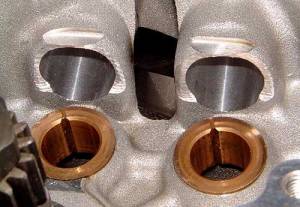 | 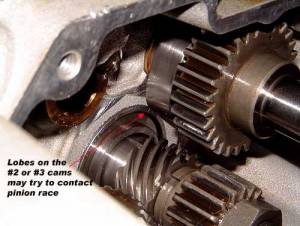 | 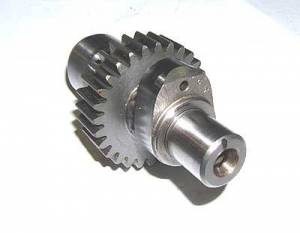 |
Another thing to check is tappet pin clearance. 4)
The tappet pin rests against the flat on the tappet to keep the tappet from rotating in the bore.
But a bigger cam lobe lifts the tappet farther and on stock lifter, it can run out of travel.
Aftermarket lifters as shown below sometimes have longer flats.
| Stock vs Jims lifter tappet flat comparison. 5) |
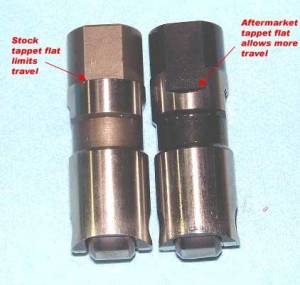 |
Small base circle cams can help with all these clearances.
It's because they achieve their extra lift, at least in part, by letting the lifter down farther as opposed to raising the lifter more.
The 575's are small base circle so it makes them simpler to install.
But small base circle cams often introduce one other problem and that's the clearance between the bottom of the tappet and the top of the cam bushing.
When the lobe sets the tappet down, the roller needs to keep following the lobe.
But sometimes with a small base circle cam the lifter will hit the cam bushing and thus not come all the way down.
Easy to fix with some careful, slight grinding on the tappet on the underside of the axle support boss.
Some cam installation links:
From Hammer Performance: http://www.hammerperf.com/ttxlcaminstall.shtml
From NRHS: http://www.nrhsperformance.com/tech_xlcaminstall.shtml
Test Fitting
Factory fitting of the cams is (or rather was) all about noise control. 6)
By selecting the cam gears sized specifically for the engine they were going in, they could walk that fine line between noisy and too-tight.
The noise from the gears being a tad loose doesn't hurt anything. Too-tight however can cause localized tooth heating and failure.
So when you replace the cams with non-original cams, you just have to make sure you're not too-tight, which is why you should do a basic test fit.
Aftermarket cams are all made on the loose side and you rarely get into trouble when using them.
In 2000, they changed the tooth cut on the pinion connection to the #2 cam, to a “high contact ratio” design.
This tooth design apparently got the noise level down to an acceptable amount without having to deal with multiple gear sizes.
There's only one size for each.
In 2001, this change was propagated to all the cam interconnecting gears as well.
To do a basic test fit of your cams.
Install all 4 cams in the gearcase with the pinion gear removed.
Use a fair amount of assembly lube in the bushings and in the gear teeth.
Rotate them by hand and make sure they all spin freely without binding.
Then, install all 4 cams in the cam cover and make sure they spin freely without binding.
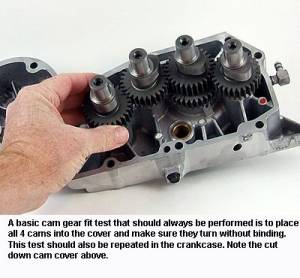 |
| Test fitting cams in the cam cover 7) |
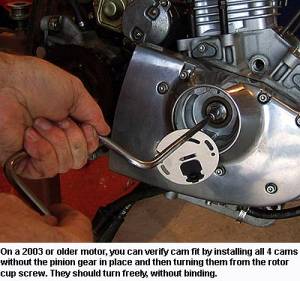 |
| Test fitting cams with the cam cover installed 8) |
